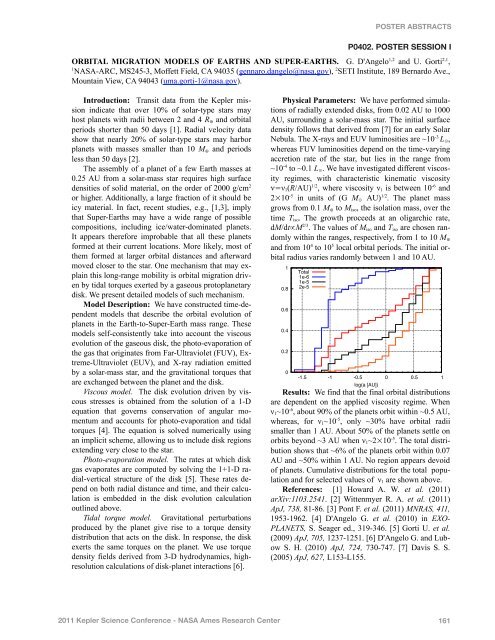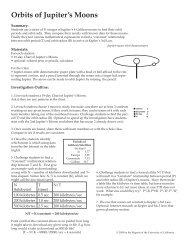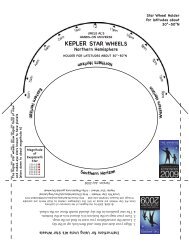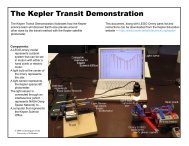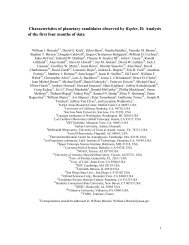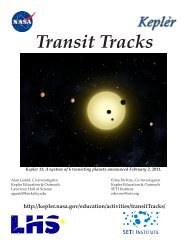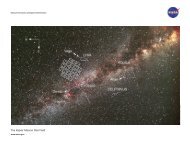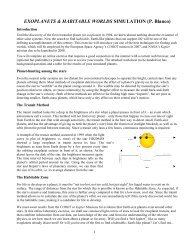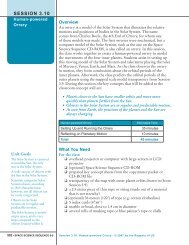Poster Abstracts - Kepler - NASA
Poster Abstracts - Kepler - NASA
Poster Abstracts - Kepler - NASA
- No tags were found...
You also want an ePaper? Increase the reach of your titles
YUMPU automatically turns print PDFs into web optimized ePapers that Google loves.
POSTER ABSTRACTSP0402. POSTER SESSION IORBITAL MIGRATION MODELS OF EARTHS AND SUPER-EARTHS. G. D'Angelo 1,2 and U. Gorti 2,1 ,1<strong>NASA</strong>-ARC, MS245-3, Moffett Field, CA 94035 (gennaro.dangelo@nasa.gov), 2 SETI Institute, 189 Bernardo Ave.,Mountain View, CA 94043 (uma.gorti-1@nasa.gov).Introduction: Transit data from the <strong>Kepler</strong> missionindicate that over 10% of solar-type stars mayhost planets with radii between 2 and 4 R ⊕ and orbitalperiods shorter than 50 days [1]. Radial velocity datashow that nearly 20% of solar-type stars may harborplanets with masses smaller than 10 M ⊕ and periodsless than 50 days [2].The assembly of a planet of a few Earth masses at0.25 AU from a solar-mass star requires high surfacedensities of solid material, on the order of 2000 g/cm 2or higher. Additionally, a large fraction of it should beicy material. In fact, recent studies, e.g., [1,3], implythat Super-Earths may have a wide range of possiblecompositions, including ice/water-dominated planets.It appears therefore improbable that all these planetsformed at their current locations. More likely, most ofthem formed at larger orbital distances and afterwardmoved closer to the star. One mechanism that may explainthis long-range mobility is orbital migration drivenby tidal torques exerted by a gaseous protoplanetarydisk. We present detailed models of such mechanism.Model Description: We have constructed time-dependentmodels that describe the orbital evolution ofplanets in the Earth-to-Super-Earth mass range. Thesemodels self-consistently take into account the viscousevolution of the gaseous disk, the photo-evaporation ofthe gas that originates from Far-Ultraviolet (FUV), Extreme-Ultraviolet(EUV), and X-ray radiation emittedby a solar-mass star, and the gravitational torques thatare exchanged between the planet and the disk.Viscous model. The disk evolution driven by viscousstresses is obtained from the solution of a 1-Dequation that governs conservation of angular momentumand accounts for photo-evaporation and tidaltorques [4]. The equation is solved numerically usingan implicit scheme, allowing us to include disk regionsextending very close to the star.Photo-evaporation model. The rates at which diskgas evaporates are computed by solving the 1+1-D radial-verticalstructure of the disk [5]. These rates dependon both radial distance and time, and their calculationis embedded in the disk evolution calculationoutlined above.Tidal torque model. Gravitational perturbationsproduced by the planet give rise to a torque densitydistribution that acts on the disk. In response, the diskexerts the same torques on the planet. We use torquedensity fields derived from 3-D hydrodynamics, highresolutioncalculations of disk-planet interactions [6].Physical Parameters: We have performed simulationsof radially extended disks, from 0.02 AU to 1000AU, surrounding a solar-mass star. The initial surfacedensity follows that derived from [7] for an early SolarNebula. The X-rays and EUV luminosities are ~10 -3 L ⊙ ,whereas FUV luminosities depend on the time-varyingaccretion rate of the star, but lies in the range from~10 -4 to ~0.1 L ⊙ . We have investigated different viscosityregimes, with characteristic kinematic viscosityν=ν 1 (R/AU) 1/2 , where viscosity ν 1 is between 10 -6 and2×10 -5 in units of (G M ⊙ AU) 1/2 . The planet massgrows from 0.1 M ⊕ to M iso , the isolation mass, over thetime T iso . The growth proceeds at an oligarchic rate,dM/dt∝M 2/3 . The values of M iso and T iso are chosen randomlywithin the ranges, respectively, from 1 to 10 M ⊕and from 10 4 to 10 5 local orbital periods. The initial orbitalradius varies randomly between 1 and 10 AU.10.80.60.40.20Total1e-61e-52e-5-1.5 -1 -0.5 0 0.5 1log(a [AU])Results: We find that the final orbital distributionsare dependent on the applied viscosity regime. Whenν 1 ~10 -6 , about 90% of the planets orbit within ~0.5 AU,whereas, for ν 1 ~10 -5 , only ~30% have orbital radiismaller than 1 AU. About 50% of the planets settle onorbits beyond ~3 AU when ν 1 ~2×10 -5 . The total distributionshows that ~6% of the planets orbit within 0.07AU and ~50% within 1 AU. No region appears devoidof planets. Cumulative distributions for the total populationand for selected values of ν 1 are shown above.References: [1] Howard A. W. et al. (2011)arXiv:1103.2541. [2] Wittenmyer R. A. et al. (2011)ApJ, 738, 81-86. [3] Pont F. et al. (2011) MNRAS, 411,1953-1962. [4] D'Angelo G. et al. (2010) in EXO-PLANETS, S. Seager ed., 319-346. [5] Gorti U. et al.(2009) ApJ, 705, 1237-1251. [6] D'Angelo G. and LubowS. H. (2010) ApJ, 724, 730-747. [7] Davis S. S.(2005) ApJ, 627, L153-L155.2011 <strong>Kepler</strong> Science Conference - <strong>NASA</strong> Ames Research Center 161


